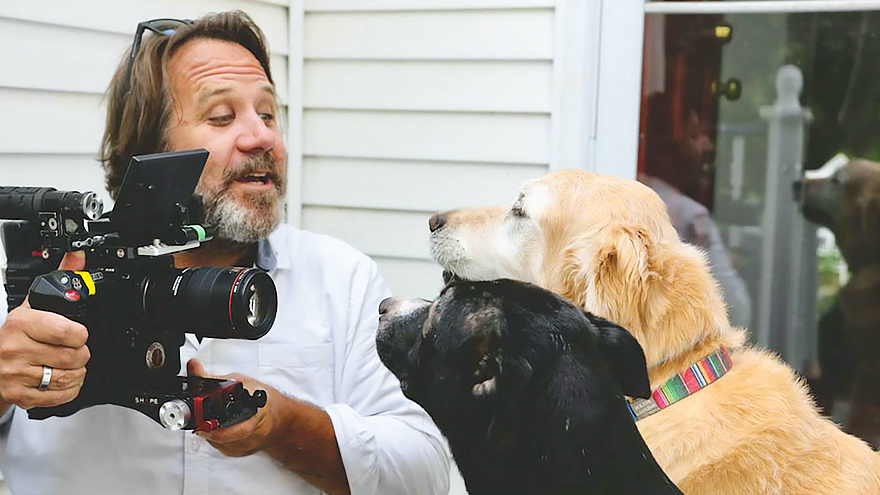One of the cool things Andy Mitchell ’96 learned while making the documentary Inside the Mind of a Dog is that dogs have unique noseprints. Like humans have fingerprints.
But learning cool things is what Mitchell has been doing for years as he has pursued a career as a cinematographer, director, writer, and producer, making films and working on everything from shorts to feature documentaries to series and commercials. Mitchell loves to tell stories and entertain people, and he particularly loves to educate viewers about the natural world. His résumé lists an impressive oeuvre of films made on every continent and in every ocean on the planet, from going deep into the Serengeti to film a “super pride” of lions to swimming with sharks and filming underwater for a Shark Week episode. He has worked with National Geographic, Disney+, Discovery Channel, Animal Planet, and Smithsonian, to name just a few of his collaborations.
He has also done projects with Netflix. In 2016, he was a cinematographer for a feature documentary on elephants; in 2021, he was the writer and showrunner for an eight-part Netflix series on penguins. Netflix knew his work, knew the awards he’d garnered. So when they wanted something done on domestic cats, they went to Mitchell and his partners. “They basically asked, what can you do for us?” Mitchell says. “So, we pitched Inside the Mind of a Cat.”
Mitchell points out, “There’s a weird spike in the science of domestic animals—people haven’t studied them so much, but now they’re focusing on them because there’s something about the human-animal connection that’s being realized as very unique.” Mitchell and his crew went to work on cats. “It was a low-budget, under-the-radar production that we thought no one would really care about. We didn’t really expect much from it—but it ended up hitting number seven in the U.S. on Netflix, as well as number five for kids, and number nine globally, all in the week it released.”
Netflix was paying attention. They wanted another film from Mitchell, this time about dogs. But they wanted it elevated. “That was their nice way of saying they didn’t want it to look low budget,” Mitchell says. They gave Mitchell the resources he needed, including bringing on board American film producer Amy Hobby, best known for producing the documentary What Happened, Miss Simone?, which earned her a nomination for an Academy Award for Best Documentary Feature. “She was like a mentor to me, a trusted soundboard, which was the best experience I’ve had in a long time.” As story producer, she helped cast the experts and draft interview questions, and helped with music, graphics, and the overall narrative. Another addition to the crew was Rob Lowe, an avowed dog lover (he has four), as narrator.
Mitchell and his coworkers dove into the process, doing extensive research and talking to every dog expert they could find. They read all the recent pertinent nature science publications and built a spreadsheet of the 36 top dog experts in the world. “We wound up finding this one guy, Brian Hare, who is widely considered the godfather of dog science. He is one of the top minds on the subject and has been for 30 years. We really wanted him to be involved.” But Hare, the founder of the Duke Canine Cognition Center, didn’t usually do collaborations of that kind. He admitted he didn’t even take meetings like the one he had with Mitchell. But he’d seen the cat movie. His wife and kids had seen the cat movie, and they loved it. They told him to be nice to Mitchell.
Hare’s help was invaluable. He works closely with the organization Canine Companions, which raises and trains service dogs, and he connected the filmmakers with the service dog team. His endorsement opened doors for Mitchell’s crew. They followed the progress of the dogs being trained at the center for months and months and were on hand at the meeting when the dogs were finally matched with their people. That’s when they met Jazmine, a 23-year-old woman with verbal communication and physical limitations, who was going to receive one of the dogs. They were welcomed by her parents to follow their story.
“That really gave us the through line we were looking for because that is what was missing in the cats documentary. We wanted there to be a story arc with the dogs and we found it with Canine Companions,” Mitchell says. “The service dog story turned out way better than we could have expected. It still makes me cry. That’s the goal. We said at the beginning that we wanted to make people cry at least once during the film.”
Mitchell takes a fluid approach to telling a story. “We don’t overscript. You write your script with the thought that this is what you think you are going to get, this would make a great movie. Then you throw the script away as soon as you get out in the field, and you tell the best story you can.” Which is exactly what happened in the dog documentary. Once they started following three dogs (Bonus, Peabody, and Nemo) at Canine Companions, they hoped to make a relationship with a recipient. They didn’t know who it would be, but they were cautiously optimistic that one of the dogs would be successfully matched. “We got very lucky with how it landed. We loved the Bonus and Jazmine connection. Kevin, Jaz’s father, was incredibly helpful and accommodating, and her family really believed in what we were doing. They gave us amazing access to a lot of private stuff, which I think really helped us.” And the family loved the movie. Jazmine felt like a rock star.

“We also loved that Peabody was matched with a recipient with PTSD. Nemo didn’t make it, but the three outcomes showed a variation of results, which worked well for the movie. We could never have predicted how it would turn out. But it’s a great example of being organic with the script process. To me, this flexibility is the nature of quality documentary filmmaking.” Audiences agreed. Within a few days of being released in August, Inside the Mind of a Dog climbed to number three in the U.S. on Netflix and number five in the world and was the number one documentary for eight days. It’s still one of Netflix’s most-liked films.
Both the film about cats and the one about dogs are indicative of a shift in Mitchell’s way of thinking about his creativity. For years he’s worked on more serious subjects, like climate change and its effect on the natural world, films he believes are important. Now he’s leaning more toward what he calls “documentary lite,” with stories that, as he says, “make you forget about the apocalypse.” He feels that sometimes you can engage people more and maybe change minds by telling fun, compelling stories rather than dire ones.
When asked about his next project, Mitchell isn’t ready to divulge any specifics at this point. But he’s quick to talk about where streaming is headed. “Our industry’s in a bit of reimagining, especially the broadcast documentary space, because people don’t necessarily want Discovery Channel anymore. The past year has been the worst year for the television industry, kind of on the heels of the strikes. It’s this crazy Wild West right now. Netflix is the standard, but the future is not Netflix. It’s YouTube and Twitch, where things are headed. The more you can be interactive and immerse people in it, the better. I equate it to the Choose Your Own Adventure books. I’ve worked out the model, but I’ve yet to get someone to allow me to do it and give me a million dollars for it.”
Change can be scary when it affects your career, unless you are prepared to evolve with it. Mitchell is clearly keeping his eye on what’s happening and preparing for what’s coming. But some things don’t change, like the way people feel about their pets. Cat lovers, dog lovers, or both—viewers will continue to enjoy Mitchell’s films for a long time.

Leave a Reply